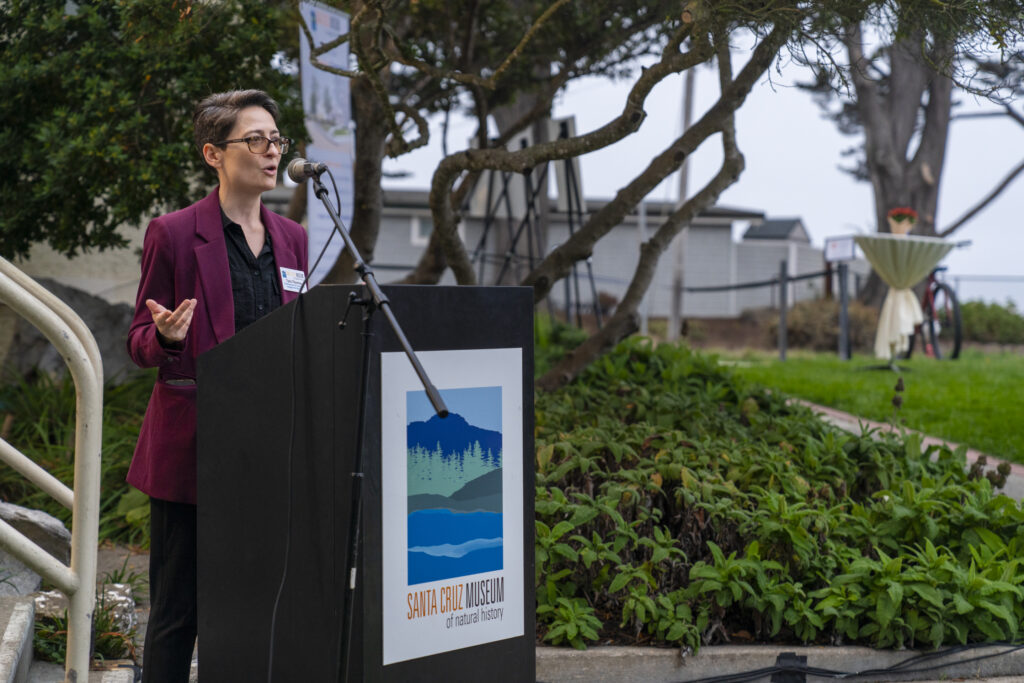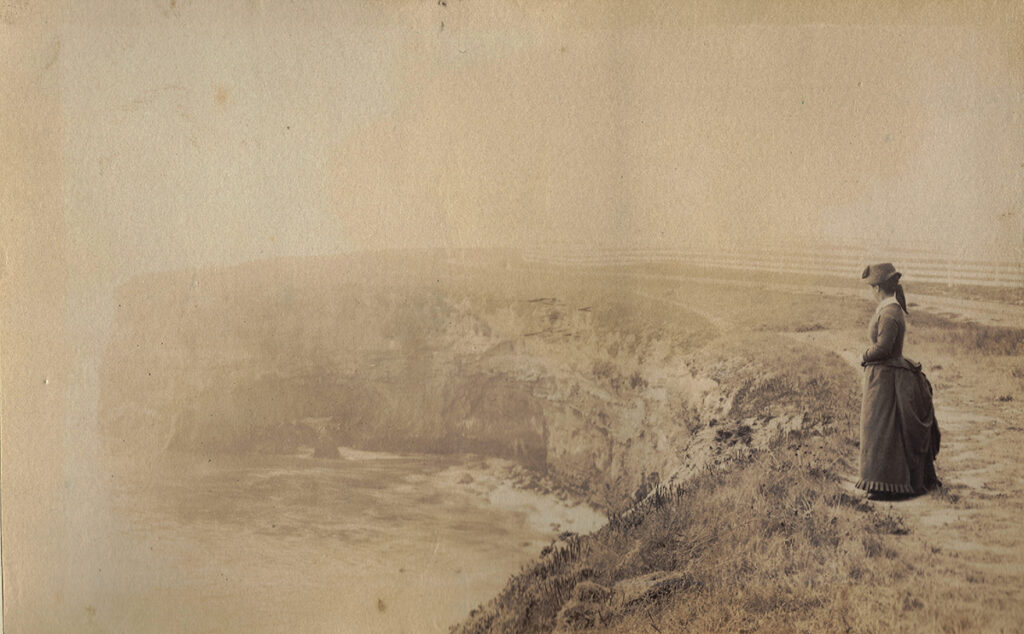Alumna Profile: Tara Thomas

Dr. Tara Thomas graduated from the Literature Department at UC Santa Cruz in 2021. During their PhD program, they were a 2019 THI Summer Research Fellow, and they were actively involved in the The Dickens Project. Since graduating, Dr. Thomas has become the Development and Community Engagement Manager at the Santa Cruz Museum of Natural History and they are continuing to teach at UC Santa Cruz as a Lecturer.
In September, we spoke with them about their current role at the museum and their continued connections to the campus. THI is co-sponsoring the Educator Workshop with the Amah Mutsun on October 5th, 2024 presented by the Santa Cruz Museum of Natural History. The Humanities Division and The Humanities Institute have also worked with Dr. Thomas to develop a paid Public Environmental Humanities internship for an undergraduate student to work with them at the museum. As the new academic year begins, we discussed why this is such an exciting opportunity, how they see the museum continuing to partner with the campus, and what advice they have for scholars working on community-facing projects.
Hi Tara! Thanks for chatting with us! We had an excellent interview with you back in 2019 when you were in the midst of your PhD program and we would love to learn about your career path since graduating from UC Santa Cruz. How have you continued to pursue your interests and how has your Humanities doctorate guided your interests and shaped your work in different fields?
Thank you so much for having me. As a doctoral student, I was very involved in my field, attending and helping organize conferences, working on collaborative digital humanities projects, and organizing public humanities projects here in Santa Cruz. My research focuses on late-Victorian literature, ancient Roman literature, and queer studies, yet I’ve always used both doctoral coursework and my own classes to teach beyond my research. Working with the Dickens Project for over ten years, I helped develop programs that transformed the project from an annual conference into an organization providing year-long programming, reaching lifelong learners and high school students beyond the university.
After graduating, I began teaching racial justice-themed core courses at UCSC’s Oakes College and working as a Researcher and Writer at Filoli, a National Trust for Historic Preservation site in the Bay Area. Filoli was a great place to start my journey because I got to be involved in a campaign instituting better wages and annual COLAs, something I had spent a lot of time advocating for as a grad student worker.

From there, I began working with educational nonprofits where I worked in grant writing and institutional partnership development to create scholarships and internships for first-generation student—rewarding work yet work that required a lot of tedious paperwork. Now, I have a more dynamic role at the Santa Cruz Museum of Natural History where I lead development, communications, and community engagement.
Working concurrently as an academic and nonprofit leader has been an interesting journey that has strengthened my teaching and research. Through my non-academic work, I get to help communicate important research and scholarship to multiple audiences—from college students to academics to lifelong learners.
Through my non-academic work, I get to help communicate important research and scholarship to multiple audiences—from college students to academics to lifelong learners.
Most of my writing these days is public-facing, and the occasional academic articles I’m writing now are deeply informed by my community engagement and teaching. I also recently returned to UCSC’s Literature Department as a lecturer, where I now regularly teach courses in my area of expertise.
For people that might not know, can you talk more about the Santa Cruz Museum of Natural History and your role as Development and Community Engagement Manager?
Absolutely! As a scholar interested in 19th-century women’s history, I have always had a deep fascination with Laura Hecox, the Santa Cruz lighthouse keeper, naturalist, and museum founder. Hecox opened the museum in 1905 with her own natural history collection.

Since then, the museum has expanded to do everything from environmental science field trips, indigenous history and culture collaborative programs with the Amah Mutsun, environmental stewardship projects, and public programs like hikes and lectures. The museum has exhibits featuring local fossils and geology, taxidermy, and a California indigenous culture exhibit. We also host special exhibits, including an upcoming “Out of this World” exhibit on astronomy featuring historical artifacts from Lick Observatory.
As the museum’s development and community engagement manager, I play a key role in helping fulfill our mission through developing partnerships and communicating the Museum’s work to public audiences. I am constantly utilizing the skillsets I cultivated as a Humanities scholar to research and write about projects that have a deep and lasting impact on the community. Collaborating with community-based organizations and other stakeholders to secure support and actualize projects is a major aspect of what I do and is one of the most rewarding parts of the job. One great example is the THI-sponsored Educator Workshop.
The Santa Cruz Museum of Natural History is presenting an Educator Workshop with the Amah Mutsun on October 5th, co-sponsored by The Humanities Institute. Can you share more about this event, who you would like to attend, and why these partnerships are important?
Each year, the museum brings educators, tribal leaders, and scholars of indigenous culture together for this day-long workshop focused on incorporating indigenous perspectives into the K-12 curriculum. This year, in large part thanks to THI’s support, I invited UCSC faculty and students interested in teaching indigenous history to join the workshop. My hope was that faculty and future educators could also benefit from engaging with the Amah Mutsun and that future educators could begin building connections with other school teachers and tribal leaders in the community.
Chairman Valentin Lopez of the Amah Mutsun Tribal Band opens the workshop with a presentation about the history of the Amah Mutsun followed by a presentation by Daisy Martin, Director of the History and Civics Project, who introduces the Critical Mission Studies project. In the afternoon, an extensive curriculum workshop provides educators time to actually revise their curricula with indigenous leaders and scholars who provide advice about how teachers can incorporate indigenous knowledge and perspectives into the K-12 classroom.
This workshop is a great example of how impactful public humanities work can be. Sixty teachers participate in this annual workshop, bringing more equitable curricula back to fellow teachers and hundreds of students each year. Teachers return to the Museum for field trips focused on indigenous culture that feature the First Peoples exhibit (also developed in consultation with the Amah Mutsun), and kids bring their families to the museum. Longtime partnerships like this create a ripple effect through the whole community, inspiring people of all ages to learn about indigenous culture and the importance of indigenous-led environmental stewardship.
You’ve also developed a Humanities EXCEL Fellowship for a UCSC undergraduate humanities student to pursue a public environmental humanities internship with the Santa Cruz Museum of Natural History this year. What prompted you to create this position for a humanities student and why is this such a special and exciting opportunity?
Creating a Humanities EXCEL Fellowship for an undergrad humanities student is a full-circle moment for me. As a former grad student instructor turned lecturer, I continue to mentor many UCSC Humanities students and grads, including helping them navigate post-grad plans that don’t always follow the academic career path. Developing internships and education programs from grant funding is an important part of my non-academic work, so creating a fellowship to help a UCSC undergrad explore how to translate Humanities research and writing to public environmental humanities projects is an incredible opportunity.
Creating a Humanities EXCEL Fellowship for an undergrad humanities student is a full-circle moment for me. As a former grad student instructor turned lecturer, I continue to mentor many UCSC Humanities students and grads, including helping them navigate post-grad plans that don’t always follow the academic career path.
The Fellow will help introduce new projects, programs, and collections acquisitions to public audiences for the first time, gaining hands-on experience working in the museum industry as a communications professional. Learning the transferability of the technical skills and how these skills align with the communications career path will definitely be a benefit of this fellowship, but the real value will come through giving the fellow the opportunity to work on public humanities projects related to their interests. Research and writing will play a key part of this fellowship and my goal is to have them walk away having completed a few impactful projects that contributed to the public’s understanding of the work we do here at the museum.
Many of our students focus on community-facing projects, what is some advice for those looking to make careers out of this type of work? Specifically, what skills or experiences are most valuable for success in community-focused roles?
Engaging in community-facing projects beyond the classroom played an instrumental role in my doctoral experience and career development. I spent all seven years of grad school (and three more years after graduation) working with a multi-research consortium called The Dickens Project, where I gained experience with everything from copyediting a peer-reviewed book to organizing conferences and developing educational programs. There are so many great institutes and programs on campus, so my advice to students is to get involved and also connect with community-based organizations beyond campus. Oakes College has a whole program called CARA that connects students to off-campus organizations doing amazing work, and there are so many other ways to connect, including through paid internships. Nonprofit Connection of Santa Cruz County also has a great job board that includes internship opportunities for young professionals.
As far as experiences and skillsets go, I think the most valuable skills are the ones students are already cultivating in the Humanities classroom. The writing, research, and critical thinking skills Humanities students develop in the classroom are invaluable in public-facing work. Publishing writing, whether it’s a poem, op-ed, or article, is also great experience. Skills aside, I think the number one most important thing is finding an organization whose work intersects with the issues that matter to you.
